Mail balloons of Lille
We can find letters to PARIS handled by the LILLE post office during the second fortnight of February 1871. Some of these letters are even marked "par ballon monté" ("by mail balloon"). Most of them were written at the end of 1870 and originated from places far from LILLE.
Little is known about the history of Lille’s mail balloons.


Letter written in DRUCOURT (Eure) on 12 November 1870. Processed in LILLE on 23 February 1871.
During the siege of Paris in 1870–1871, sending mail out of the capital via mail balloons was relatively easy. In total, between 23 September 1870 and 28 January 1871, 55 balloons successfully carried mail out of the city.
In the opposite direction, however, getting mail into Paris was far more challenging, despite the Administration’s efforts to establish postal links with the capital.
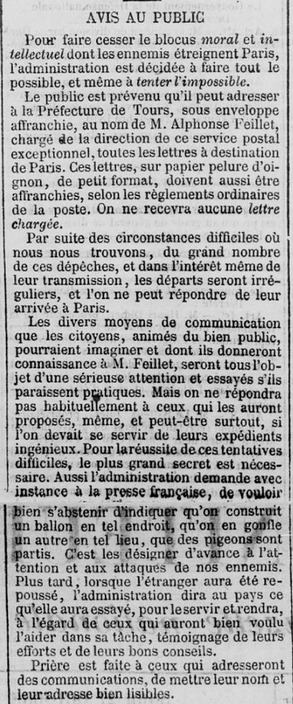

Moniteur Universel of 27 October 1870.
At first, the telegraph was used, but the cables to PARIS were cut by the Germans, and various attempts to restore them failed.
The carrier pigeon service, which transported microphotographic dispatches, was opened to the public by a decree on 4 November 1870 (Monthly Bulletin no. 28, July 1871). However, the number of pigeons capable of covering long distances was limited. In addition, winter conditions and reduced daylight hours affected their performance.
Finally, the idea arose of using balloons departing from PARIS to send them back there. However, as the balloons of the time were not yet steerable, their return to the capital depended entirely on the whims of the wind.
Moreover, the German-occupied zones around Paris were expanding daily, making it increasingly difficult to depart from a town close enough to the capital. Additionally, such a town needed to have a gas plant powerful enough to inflate a balloon quickly.
Nevertheless, on 9 November, the Post Office published the following notice in the Moniteur Universel.
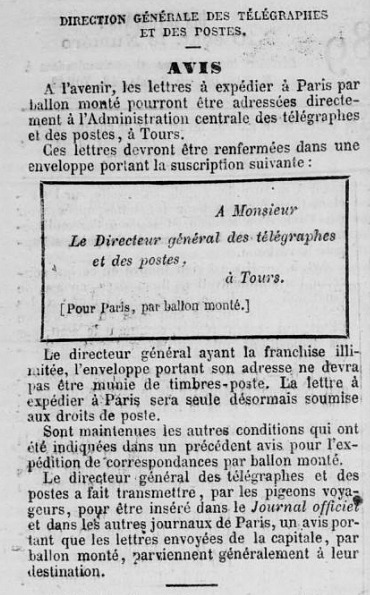

Postage due letter written in MARSEILLE on 16 November 1870. Processed in LILLE on 25 February, it arrived in PARIS on 27 February.
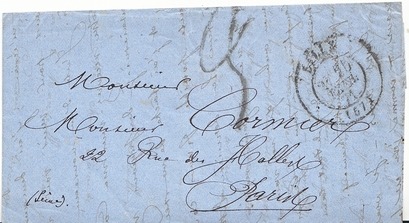

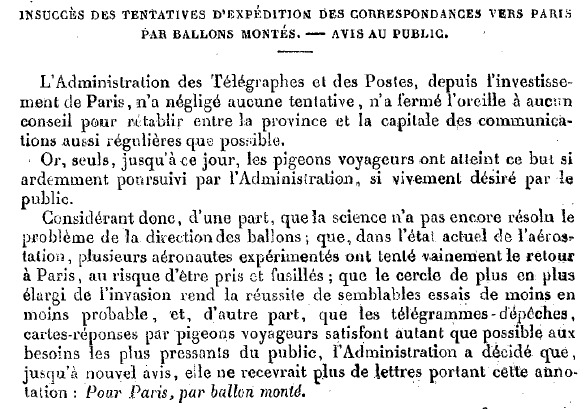

Extract from the notice published in the Moniteur Universel of Bordeaux on 21 December 1870 (Monthly Bulletin no. 28 July 1871).
In reality, this notice did not put an end to attempts to return to PARIS, as other methods were subsequently tested, such as the Boules de Moulins (Moulins balls). It is even possible that the notice was also intended to mislead the enemy. Indeed, the Germans were aware of efforts to re-establish communications with PARIS. François-Frédéric Steenackers, Director General of Telegraphs and Posts, recounts in his book [1]:
"This second notice [that of 27 October] was a matter of order, a sort of recommendation for discretion to inventors and the press. Alas! I was preaching in the wilderness. The newspapers – with no ill intent, I am sure – reported on the balloon journeys, the return tests, and so on. Those who had the greatest interest in keeping silent, despite all our pleas, revealed the secret to anyone who would listen."
A large quantity of mail had accumulated following the notices of 27 October and 9 November, yet no effective means had been found to send it to the capital.
In Paris, the Minister of Public Works, Dorian, instructed Bunelle and De Fonvielle to coordinate with the government delegation in TOURS to organise an attempt to return to the capital [2].
De Fonvielle and Bunelle knew each other well. During the siege, Bunelle had established a private company chartering balloons for individuals and had recruited De Fonvielle. Both had left PARIS on 24 November 1870 aboard the Égalité balloon, accompanied by three passengers and carrying a letter from Minister Dorian to Steenackers. After landing in LOUVAIN (Belgium), Bunelle headed for TOURS, while De Fonvielle travelled to England.
Upon arriving in TOURS, Bunelle telegraphed a friend in Paris on 1 December: "Well, rough journey, received important aeronautical mission […]"[3].
This "important mission" was to establish an aerostatics station, which he would oversee. The station was set up in LILLE at the beginning of January 1871 in buildings provided by Lille Town Hall.
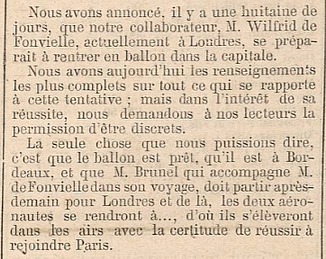

Extract from the newspaper La Liberté (Montpellier) of 13 January 1871. Bunelle is referred to as Brunel.
Initially, the station was equipped with three balloons brought back from BORDEAUX after a long sea voyage. Later, all balloons that had fallen near Nord department and in Belgium, including the Duquesne (a balloon with a propeller gondola), were added to the LILLE fleet. According to De Fonvielle, the purpose of this station was to establish communication between the Armée du Nord, headquartered in LILLE, and PARIS.
No public announcement was made regarding this initiative. The Administration simply redirected part of the stock of letters bound for PARIS—collected in TOURS—to LILLE. This explains why some letters processed in LILLE bear the markings "par ballon" or "ballon monté", following the notice of 9 November 1870.
The staff at the LILLE aeronautical station were unable to attempt a balloon launch, as the winds in January were unfavourable. Conditions improved towards the end of the month, but the Armistice signed on 28 January rendered the LILLE station and its balloons obsolete.
Bunelle remained in LILLE for some time and made a few charity ascents, but the station was officially closed on 22 February 1871.
The mail collected in LILLE was forwarded to PARIS between 14 and 28 February 1871, as indicated by LILLE date stamps.
References:
[1] Les télégraphes et les postes pendant la guerre de 1870-1871, François-Frédéric Steenackers, 1883, p. 491.
[2] Le Spectateur Militaire, Henri Noirot, 1890, p. 162.
[3] Recueil des dépêches télégraphiques reproduites par la photographie et adressées à Paris au moyen de pigeons voyageurs, Volume IV.
However, several attempts from Chartres on 20 October, and from ROUEN on 7 and 8 November with the Jean-Bart, were unsuccessful. Another balloon made attempts from AMIENS during the first ten days of November, but again without success.
In light of this evidence, the Administration published the following notice in the Moniteur Universel on 21 December 1870, announcing the end of experiments to return to Paris by balloon.

